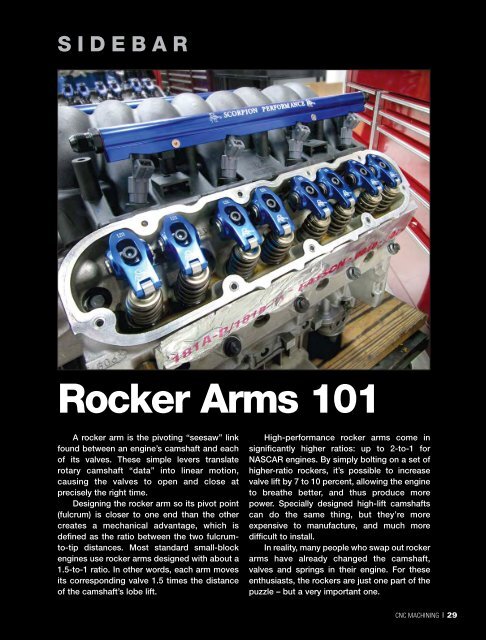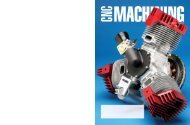The EC-630PP HMC - Haas - Haas Automation, Inc.
The EC-630PP HMC - Haas - Haas Automation, Inc.
The EC-630PP HMC - Haas - Haas Automation, Inc.
You also want an ePaper? Increase the reach of your titles
YUMPU automatically turns print PDFs into web optimized ePapers that Google loves.
SIDEBAR<br />
Rocker Arms 101<br />
A rocker arm is the pivoting “seesaw” link<br />
found between an engine’s camshaft and each<br />
of its valves. <strong>The</strong>se simple levers translate<br />
rotary camshaft “data” into linear motion,<br />
causing the valves to open and close at<br />
precisely the right time.<br />
Designing the rocker arm so its pivot point<br />
(fulcrum) is closer to one end than the other<br />
creates a mechanical advantage, which is<br />
defined as the ratio between the two fulcrumto-tip<br />
distances. Most standard small-block<br />
engines use rocker arms designed with about a<br />
1.5-to-1 ratio. In other words, each arm moves<br />
its corresponding valve 1.5 times the distance<br />
of the camshaft’s lobe lift.<br />
High-performance rocker arms come in<br />
significantly higher ratios: up to 2-to-1 for<br />
NASCAR engines. By simply bolting on a set of<br />
higher-ratio rockers, it’s possible to increase<br />
valve lift by 7 to 10 percent, allowing the engine<br />
to breathe better, and thus produce more<br />
power. Specially designed high-lift camshafts<br />
can do the same thing, but they’re more<br />
expensive to manufacture, and much more<br />
difficult to install.<br />
In reality, many people who swap out rocker<br />
arms have already changed the camshaft,<br />
valves and springs in their engine. For these<br />
enthusiasts, the rockers are just one part of the<br />
puzzle – but a very important one.<br />
CNC MACHINING | 29



